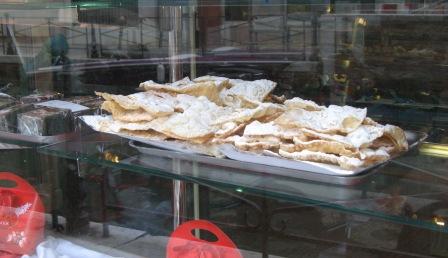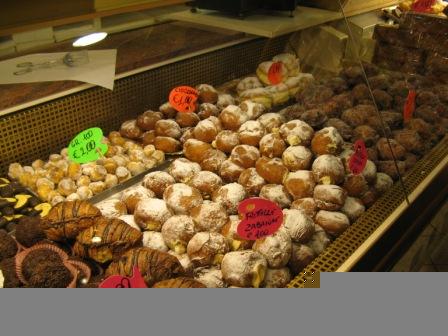You can have your first robin of spring — yesterday I detected the very first signs of Carnival .
The official Carnival celebrations this year will be running from February 6 to 16. Does ten days sound like not very many? Unless you’re a hotel owner, or a street cleaner in need of overtime, they’re more than enough, because each day will be filled with many, many tourists. In the sense that the Serengeti migration involves many, many wildebeest.
But in our little corner of the city, the signs are more appealing:
The first sprinkles of colored paper, thrown at random by small-to-smallish children. They haven’t even put on their costumes yet; for them, it’s enough to have a bag of confetti and an adult who is looking somewhere else.

And pastry!! Specifically, frittelle (free-TELL-eh) or, in Venetian, fritole (FREE-to-eh), and galani (gah-LAH-nee).

Our neighborhood pastry-shop (above) makes what I used to think were the best galani in the universe (if you will disregard their lavish use of powdered sugar, which is wrong). That was until I tried making them myself.
For the cost of a few fundamental ingredients and a couple of hours, you have a high probability, as a scientist would say, of producing something like this:

Fritole are another matter. As something to eat, they are less thrilling than galani (they trade the crunch factor for the dense-and-spongy factor), and as something to make, they’re even more work, though real Venetian housewives will deny it. I make no comment, I only observe that these women have had decades of a head start on me.

Fritole involve yeast, and substantial quantities of hot oil, neither of which appeals to me — speaking as the maker, I mean, not the consumer.
Classic Venetian fritole contain bits of raisins and/or candied fruit, are covered in normal (again, not powdered) sugar, and are both crunchy and soft, in just the right proportions. I can’t tell you what those are — you’ll know them when you taste them.
Venetian fritole are becoming so rare that shops will put up a sign announcing they have them. Evidently the same impulse (culinary, commercial, cultural) which has turned the simple Christmas fugassa into a panettone that’s become a cross between a pinata and a myocardial infarction has also struck this classic Carnival treat.

Now you get fritole filled with thick cream or zabaglione, and covered with powdered sugar. These are, as the Good Book puts it, an abomination and a hissing. But they sell, and I’m not sure what the Good Book has to say about that.
As a bonus, I mention the unheralded but modestly good castagnole (kas-tan-YOLE-eh), which are essentially doughnut holes. They’re much easier to fix than fritole, if the recipes I found can be believed, and they are also approved (by me) for Carnival authenticity.
Here are the essential recipes, taken from my own culinary good book, my trusty “Cento Antiche Ricette di Cucina Veneziana” (One Hundred Ancient Recipes of Venetian Cooking):
GALANI
Ingredients: 1/2 kilo (1 pound) flour, 2 eggs, 30 grams (1 oz) butter, 10 grams (1/3 oz) “vanilla’d sugar” (zucchero vanigliato) or a few drops of vanilla extract, a pinch of salt, and a small glass of rum or other liqueur. Oil for frying (peanut is good; I use sunflower. They say you can also use lard. I’ll stand back.)
Mix all ingredients (your hands are the only effective option), divide the dough into portions about the size of a baseball (or bocce ball, if you wish).
Roll out on a floured surface with a rolling pin till the dough is about as thick as a sheet of paper. I’m serious about this. I know it’s a lot of work — the dough becomes more elastic and resistant to being rolled the more you keep at it — but if you fudge on this part you’ll never get the result you want. The first time I made these I stopped rolling when the dough was the thickness of carton, and they were a spectacular disaster. So just make up your mind to it.
Cut the PAPER-THIN sheet of dough into strips that are somewhere between a square and a rectangle, no longer than the span of your hand. (“One Hundred Recipes” says to tie each into a knot, but I’ve never seen them like this.) I say cut them into whatever shape you want as long as it’s not too big.
Lay them, a few strips at a time, in the extremely-hot-but-not-boiling oil. Watch them turn brown. (No need to turn them.) Remove quickly — they are born with an innate desire to burn and turn black — and put on paper towels.
Sprinkle with sugar. If you want to use powdered sugar, go ahead. You’re the one who’ll be eating them, and I won’t be there to check up on you.
Unfortunately, as fabulous as these are when they’re just made, they stay almost as good for days. So don’t feel you must consume them all at one go. Then again, it’s Carnival, so the rules have been disabled. Live it up.
FRITOLE
Ingredients: yeast, flour, raisins, pine nuts, candied lemon, one or two small glasses of some liqueur. Cooking oil (or lard).
I’m sorry I can’t be more precise; “One Hundred Recipes” sometimes falls back on the old-fashioned “you’ll know it when you see it” approach to quantities.
Dissolve the yeast in a little warm water with a little flour in a wooden bowl and place it near a source of warmth.
When it begins to rise, add the raisins, pine nuts, and liqueur. Mix “forcefully,” they say.
Add more flour, but make sure the mixture remains semi-liquid.
Cover the bowl with a cloth and put it back in the warm spot till the yeast has completely risen. (“You’ll know it when you see it.”)
Take soup-spoon-sized portions of the dough and drop in the hot oil. They say boiling oil — you’re on your own here.
Cook till done (ditto). Sprinkle with sugar.

CASTAGNOLE
Ingredients: 300 grams (10 oz) flour, 60 grams (2 oz) sugar, 50 grams (1 1/2 oz) butter, 2 eggs, 1 envelope of yeast (no quantity of contents given, hm…), two soup-spoons of rum or grappa, a pinch of salt, grated rind of one lemon or orange, Alchermes, powdered sugar, oil for frying.
Mix all the ingredients except the powdered sugar, oil, and Alchermes.
Let the dough “rest” for half an hour.
Make little balls (size of golf balls) of the dough and fry in the oil for about 15 minutes.
Take out and place on paper towels. While they’re still hot, pour a few drops of the Alchermes on each and sprinkle with the powdered sugar.
ALCHERMES
This is a bonus for all of you who want to go the distance, and to have something unusual (and probably delectable — I haven’t tried this. Yet.) in the house. It sounds good enough to rate being included in almost every recipe I can think of: pot roast, lasagne, creamed chipped beef on toast, Waldorf salad…
I am making a moderately educated guess that it’s pronounced Al-ker-MESS.
350 grams (12 oz) grain alcohol, 350 grams (12 oz) sugar, 500 grams (17 oz) water, 5 grams (1/10 oz) stick cinnamon, 1 gram (a pinch, I’d say) each of cloves,cardamom, and vanilla, 60 grams(2 oz) rosewater (the cooking, not the cosmetic, variety) and 4 grams (a few drops) carmine, otherwise known as Red Dye E 120.
My source gives no procedure at this point, so I’m going to suppose that you mix it all together, pour it into a container which closes tightly, put it somewhere dark, and don’t take it out for a while. Perhaps a long while.
Interesting historical note: You will already have assumed that this potion has Arabic roots because of the first syllable “al.” It’s a concoction once popular in Southern Italy and Sicily (where there was a notable Arab influence). It was customarily given to children to calm them whenever they were stricken with fear, profoundly shocked, moderately upset, slightly annoyed… Actually, I believe it was mainly administered in extreme situations, which in a region subject to earthquakes and eruptions aren’t completely theoretical.
If I were a southern Italian child, though, I’d make a point of evincing drastic distress every once in a while just to be able to taste this elixir. I imagine that life as a southern Italian child could be rife with possibilities to evince distress even without extreme natural events. Sunday lunch with the relatives comes to mind.
More on Carnival along the way.

2 Comments
Naughty girl! You made my (homesick) mouth water ;-)!
I’ll make you some next time you come to Venice, even if it’s Ferragosto. Promise.